Advanced Taxation Essay: UK Measures to Avoid Tax Avoidance
VerifiedAdded on 2022/10/10
|12
|3511
|74
Essay
AI Summary
This essay critically evaluates the UK's approach to tax avoidance, focusing on the General Anti-Abuse Rule (GAAR) and Base Erosion and Profit Shifting (BEPS). It examines the attitudes towards tax avoidance in recent years, highlighting the increasing public scrutiny and the UK government's response. The essay analyzes HM Revenue & Customs' (HMRC) strategies, including the implementation of GAAR and other measures to manage the risk of tax avoidance. Furthermore, it assesses the impact of BEPS and the reactions of both the UK and international governments. The study explores the measures taken by the UK government to prevent tax avoidance, the necessity of the assessment of GAAR, and the role of HMRC in managing tax-related issues. The essay also touches upon the role of major audit firms in facilitating tax avoidance schemes and the impact of tax avoidance on the UK economy. It emphasizes the importance of tax planning and the significance of GAAR in curbing abusive tax arrangements and protecting the interests of loyal taxpayers. The essay concludes by examining the BEPS strategy adopted by individuals and multinational corporations and the framework implemented by OECD to tackle tax avoidance.
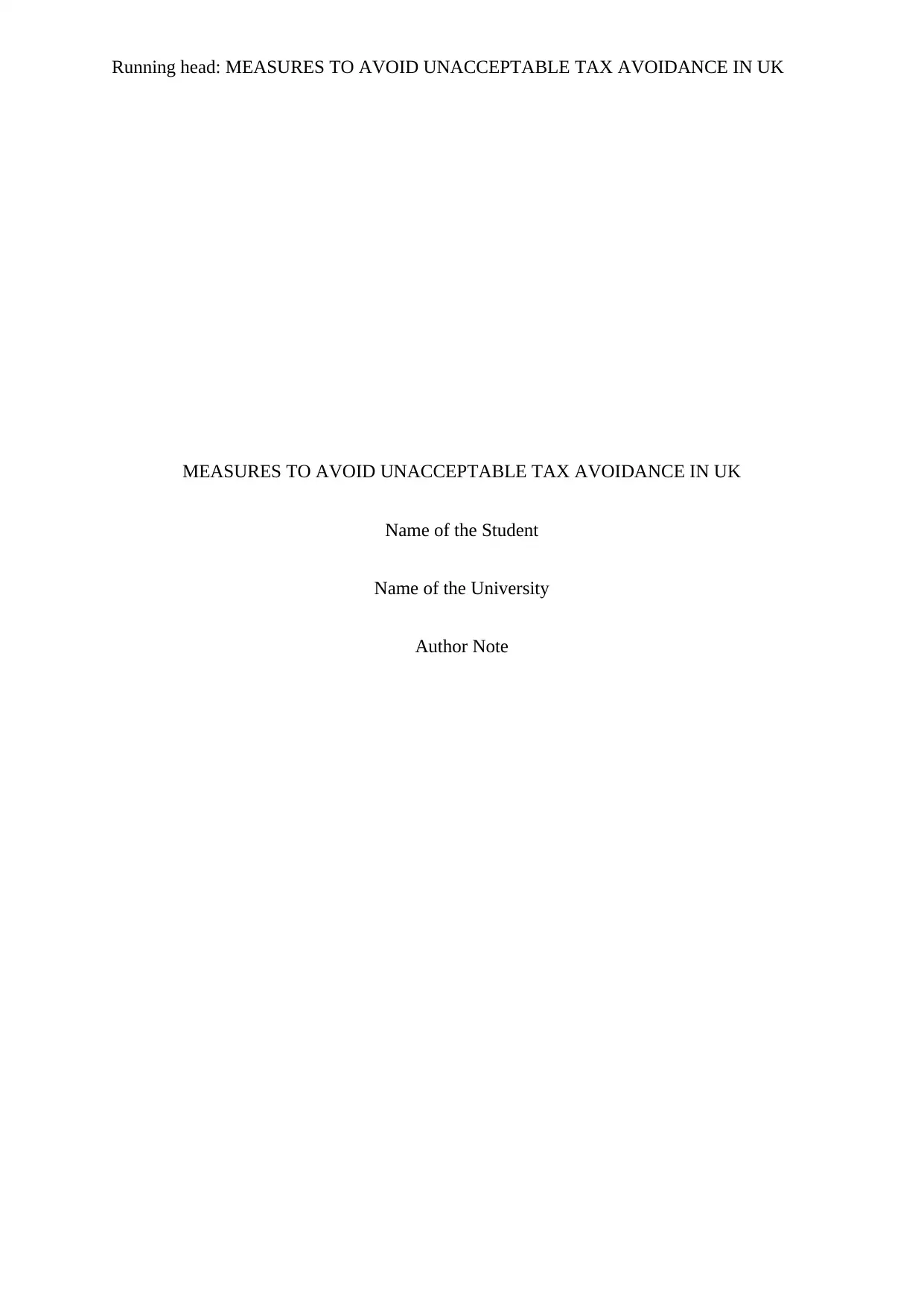
Running head: MEASURES TO AVOID UNACCEPTABLE TAX AVOIDANCE IN UK
MEASURES TO AVOID UNACCEPTABLE TAX AVOIDANCE IN UK
Name of the Student
Name of the University
Author Note
MEASURES TO AVOID UNACCEPTABLE TAX AVOIDANCE IN UK
Name of the Student
Name of the University
Author Note
Paraphrase This Document
Need a fresh take? Get an instant paraphrase of this document with our AI Paraphraser
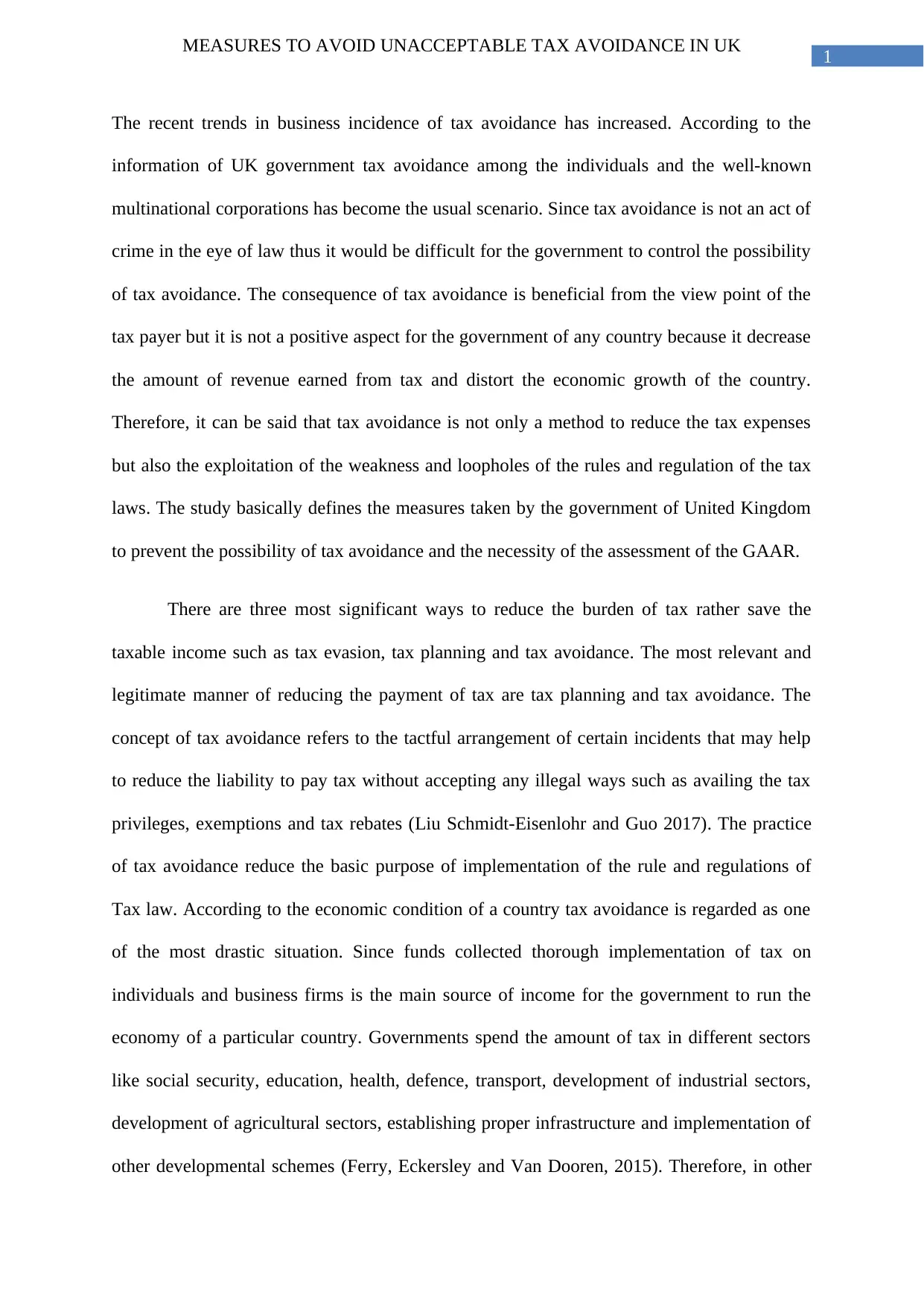
1
MEASURES TO AVOID UNACCEPTABLE TAX AVOIDANCE IN UK
The recent trends in business incidence of tax avoidance has increased. According to the
information of UK government tax avoidance among the individuals and the well-known
multinational corporations has become the usual scenario. Since tax avoidance is not an act of
crime in the eye of law thus it would be difficult for the government to control the possibility
of tax avoidance. The consequence of tax avoidance is beneficial from the view point of the
tax payer but it is not a positive aspect for the government of any country because it decrease
the amount of revenue earned from tax and distort the economic growth of the country.
Therefore, it can be said that tax avoidance is not only a method to reduce the tax expenses
but also the exploitation of the weakness and loopholes of the rules and regulation of the tax
laws. The study basically defines the measures taken by the government of United Kingdom
to prevent the possibility of tax avoidance and the necessity of the assessment of the GAAR.
There are three most significant ways to reduce the burden of tax rather save the
taxable income such as tax evasion, tax planning and tax avoidance. The most relevant and
legitimate manner of reducing the payment of tax are tax planning and tax avoidance. The
concept of tax avoidance refers to the tactful arrangement of certain incidents that may help
to reduce the liability to pay tax without accepting any illegal ways such as availing the tax
privileges, exemptions and tax rebates (Liu Schmidt-Eisenlohr and Guo 2017). The practice
of tax avoidance reduce the basic purpose of implementation of the rule and regulations of
Tax law. According to the economic condition of a country tax avoidance is regarded as one
of the most drastic situation. Since funds collected thorough implementation of tax on
individuals and business firms is the main source of income for the government to run the
economy of a particular country. Governments spend the amount of tax in different sectors
like social security, education, health, defence, transport, development of industrial sectors,
development of agricultural sectors, establishing proper infrastructure and implementation of
other developmental schemes (Ferry, Eckersley and Van Dooren, 2015). Therefore, in other
MEASURES TO AVOID UNACCEPTABLE TAX AVOIDANCE IN UK
The recent trends in business incidence of tax avoidance has increased. According to the
information of UK government tax avoidance among the individuals and the well-known
multinational corporations has become the usual scenario. Since tax avoidance is not an act of
crime in the eye of law thus it would be difficult for the government to control the possibility
of tax avoidance. The consequence of tax avoidance is beneficial from the view point of the
tax payer but it is not a positive aspect for the government of any country because it decrease
the amount of revenue earned from tax and distort the economic growth of the country.
Therefore, it can be said that tax avoidance is not only a method to reduce the tax expenses
but also the exploitation of the weakness and loopholes of the rules and regulation of the tax
laws. The study basically defines the measures taken by the government of United Kingdom
to prevent the possibility of tax avoidance and the necessity of the assessment of the GAAR.
There are three most significant ways to reduce the burden of tax rather save the
taxable income such as tax evasion, tax planning and tax avoidance. The most relevant and
legitimate manner of reducing the payment of tax are tax planning and tax avoidance. The
concept of tax avoidance refers to the tactful arrangement of certain incidents that may help
to reduce the liability to pay tax without accepting any illegal ways such as availing the tax
privileges, exemptions and tax rebates (Liu Schmidt-Eisenlohr and Guo 2017). The practice
of tax avoidance reduce the basic purpose of implementation of the rule and regulations of
Tax law. According to the economic condition of a country tax avoidance is regarded as one
of the most drastic situation. Since funds collected thorough implementation of tax on
individuals and business firms is the main source of income for the government to run the
economy of a particular country. Governments spend the amount of tax in different sectors
like social security, education, health, defence, transport, development of industrial sectors,
development of agricultural sectors, establishing proper infrastructure and implementation of
other developmental schemes (Ferry, Eckersley and Van Dooren, 2015). Therefore, in other
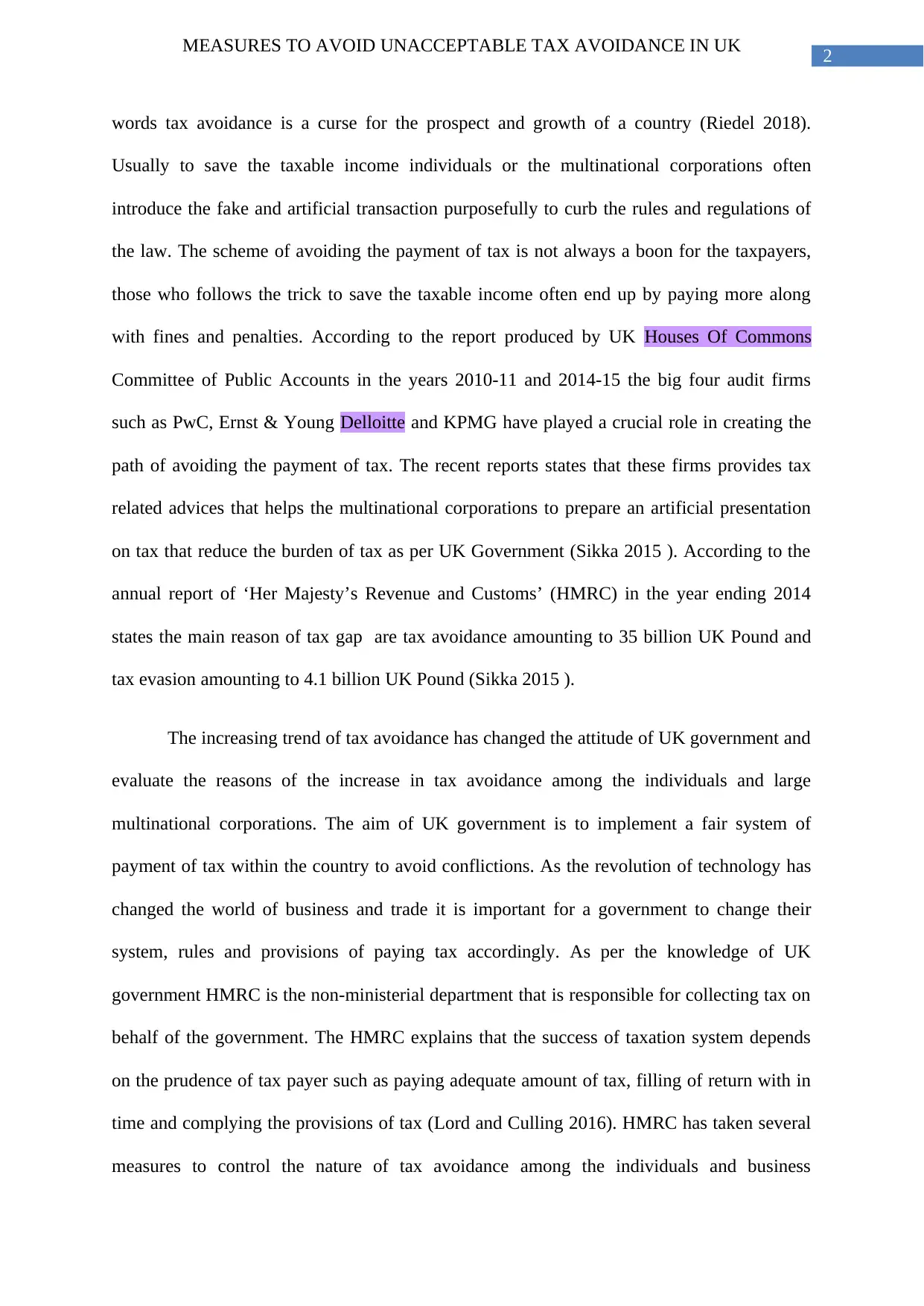
2
MEASURES TO AVOID UNACCEPTABLE TAX AVOIDANCE IN UK
words tax avoidance is a curse for the prospect and growth of a country (Riedel 2018).
Usually to save the taxable income individuals or the multinational corporations often
introduce the fake and artificial transaction purposefully to curb the rules and regulations of
the law. The scheme of avoiding the payment of tax is not always a boon for the taxpayers,
those who follows the trick to save the taxable income often end up by paying more along
with fines and penalties. According to the report produced by UK Houses Of Commons
Committee of Public Accounts in the years 2010-11 and 2014-15 the big four audit firms
such as PwC, Ernst & Young Delloitte and KPMG have played a crucial role in creating the
path of avoiding the payment of tax. The recent reports states that these firms provides tax
related advices that helps the multinational corporations to prepare an artificial presentation
on tax that reduce the burden of tax as per UK Government (Sikka 2015 ). According to the
annual report of ‘Her Majesty’s Revenue and Customs’ (HMRC) in the year ending 2014
states the main reason of tax gap are tax avoidance amounting to 35 billion UK Pound and
tax evasion amounting to 4.1 billion UK Pound (Sikka 2015 ).
The increasing trend of tax avoidance has changed the attitude of UK government and
evaluate the reasons of the increase in tax avoidance among the individuals and large
multinational corporations. The aim of UK government is to implement a fair system of
payment of tax within the country to avoid conflictions. As the revolution of technology has
changed the world of business and trade it is important for a government to change their
system, rules and provisions of paying tax accordingly. As per the knowledge of UK
government HMRC is the non-ministerial department that is responsible for collecting tax on
behalf of the government. The HMRC explains that the success of taxation system depends
on the prudence of tax payer such as paying adequate amount of tax, filling of return with in
time and complying the provisions of tax (Lord and Culling 2016). HMRC has taken several
measures to control the nature of tax avoidance among the individuals and business
MEASURES TO AVOID UNACCEPTABLE TAX AVOIDANCE IN UK
words tax avoidance is a curse for the prospect and growth of a country (Riedel 2018).
Usually to save the taxable income individuals or the multinational corporations often
introduce the fake and artificial transaction purposefully to curb the rules and regulations of
the law. The scheme of avoiding the payment of tax is not always a boon for the taxpayers,
those who follows the trick to save the taxable income often end up by paying more along
with fines and penalties. According to the report produced by UK Houses Of Commons
Committee of Public Accounts in the years 2010-11 and 2014-15 the big four audit firms
such as PwC, Ernst & Young Delloitte and KPMG have played a crucial role in creating the
path of avoiding the payment of tax. The recent reports states that these firms provides tax
related advices that helps the multinational corporations to prepare an artificial presentation
on tax that reduce the burden of tax as per UK Government (Sikka 2015 ). According to the
annual report of ‘Her Majesty’s Revenue and Customs’ (HMRC) in the year ending 2014
states the main reason of tax gap are tax avoidance amounting to 35 billion UK Pound and
tax evasion amounting to 4.1 billion UK Pound (Sikka 2015 ).
The increasing trend of tax avoidance has changed the attitude of UK government and
evaluate the reasons of the increase in tax avoidance among the individuals and large
multinational corporations. The aim of UK government is to implement a fair system of
payment of tax within the country to avoid conflictions. As the revolution of technology has
changed the world of business and trade it is important for a government to change their
system, rules and provisions of paying tax accordingly. As per the knowledge of UK
government HMRC is the non-ministerial department that is responsible for collecting tax on
behalf of the government. The HMRC explains that the success of taxation system depends
on the prudence of tax payer such as paying adequate amount of tax, filling of return with in
time and complying the provisions of tax (Lord and Culling 2016). HMRC has taken several
measures to control the nature of tax avoidance among the individuals and business
⊘ This is a preview!⊘
Do you want full access?
Subscribe today to unlock all pages.

Trusted by 1+ million students worldwide
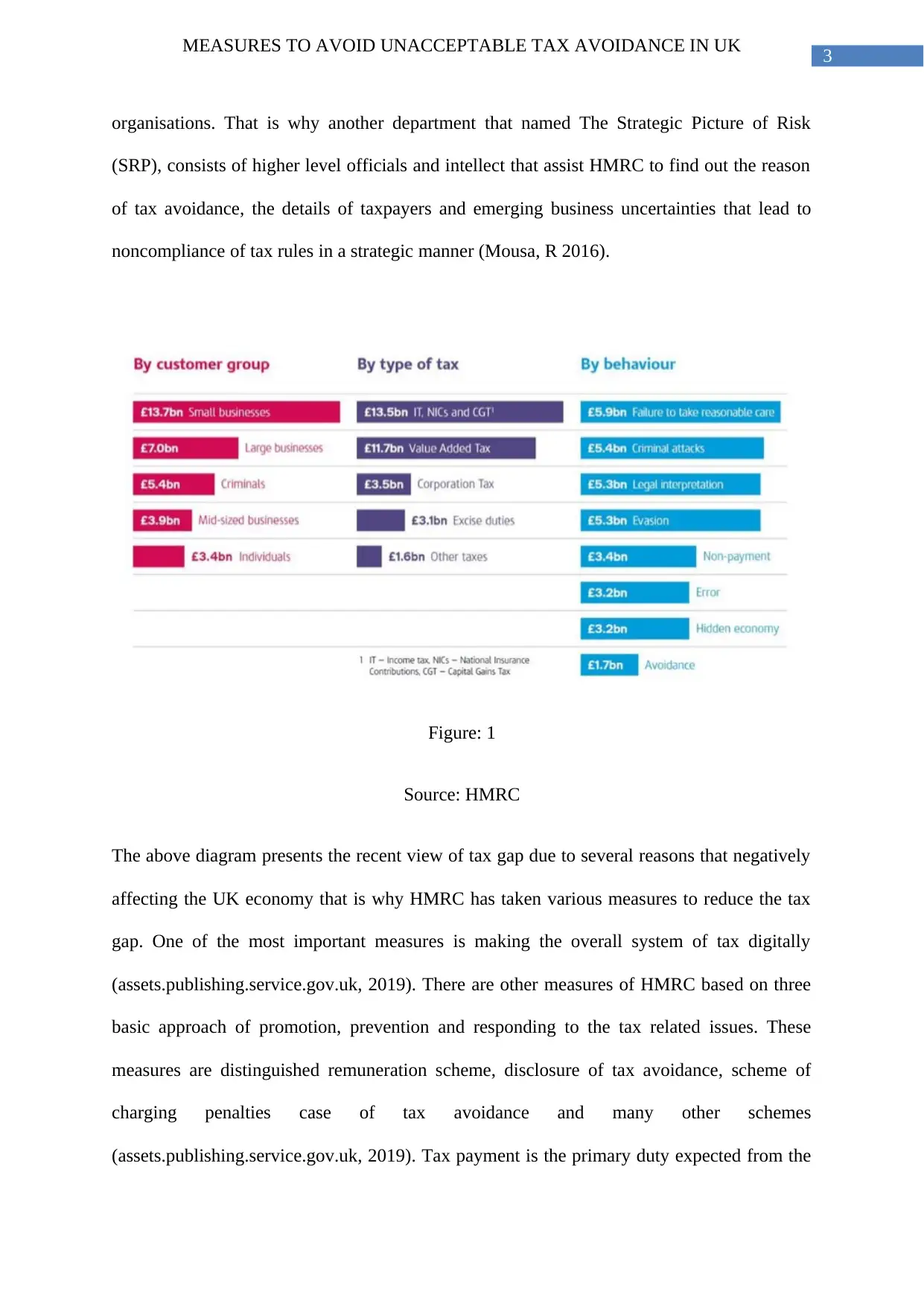
3
MEASURES TO AVOID UNACCEPTABLE TAX AVOIDANCE IN UK
organisations. That is why another department that named The Strategic Picture of Risk
(SRP), consists of higher level officials and intellect that assist HMRC to find out the reason
of tax avoidance, the details of taxpayers and emerging business uncertainties that lead to
noncompliance of tax rules in a strategic manner (Mousa, R 2016).
Figure: 1
Source: HMRC
The above diagram presents the recent view of tax gap due to several reasons that negatively
affecting the UK economy that is why HMRC has taken various measures to reduce the tax
gap. One of the most important measures is making the overall system of tax digitally
(assets.publishing.service.gov.uk, 2019). There are other measures of HMRC based on three
basic approach of promotion, prevention and responding to the tax related issues. These
measures are distinguished remuneration scheme, disclosure of tax avoidance, scheme of
charging penalties case of tax avoidance and many other schemes
(assets.publishing.service.gov.uk, 2019). Tax payment is the primary duty expected from the
MEASURES TO AVOID UNACCEPTABLE TAX AVOIDANCE IN UK
organisations. That is why another department that named The Strategic Picture of Risk
(SRP), consists of higher level officials and intellect that assist HMRC to find out the reason
of tax avoidance, the details of taxpayers and emerging business uncertainties that lead to
noncompliance of tax rules in a strategic manner (Mousa, R 2016).
Figure: 1
Source: HMRC
The above diagram presents the recent view of tax gap due to several reasons that negatively
affecting the UK economy that is why HMRC has taken various measures to reduce the tax
gap. One of the most important measures is making the overall system of tax digitally
(assets.publishing.service.gov.uk, 2019). There are other measures of HMRC based on three
basic approach of promotion, prevention and responding to the tax related issues. These
measures are distinguished remuneration scheme, disclosure of tax avoidance, scheme of
charging penalties case of tax avoidance and many other schemes
(assets.publishing.service.gov.uk, 2019). Tax payment is the primary duty expected from the
Paraphrase This Document
Need a fresh take? Get an instant paraphrase of this document with our AI Paraphraser
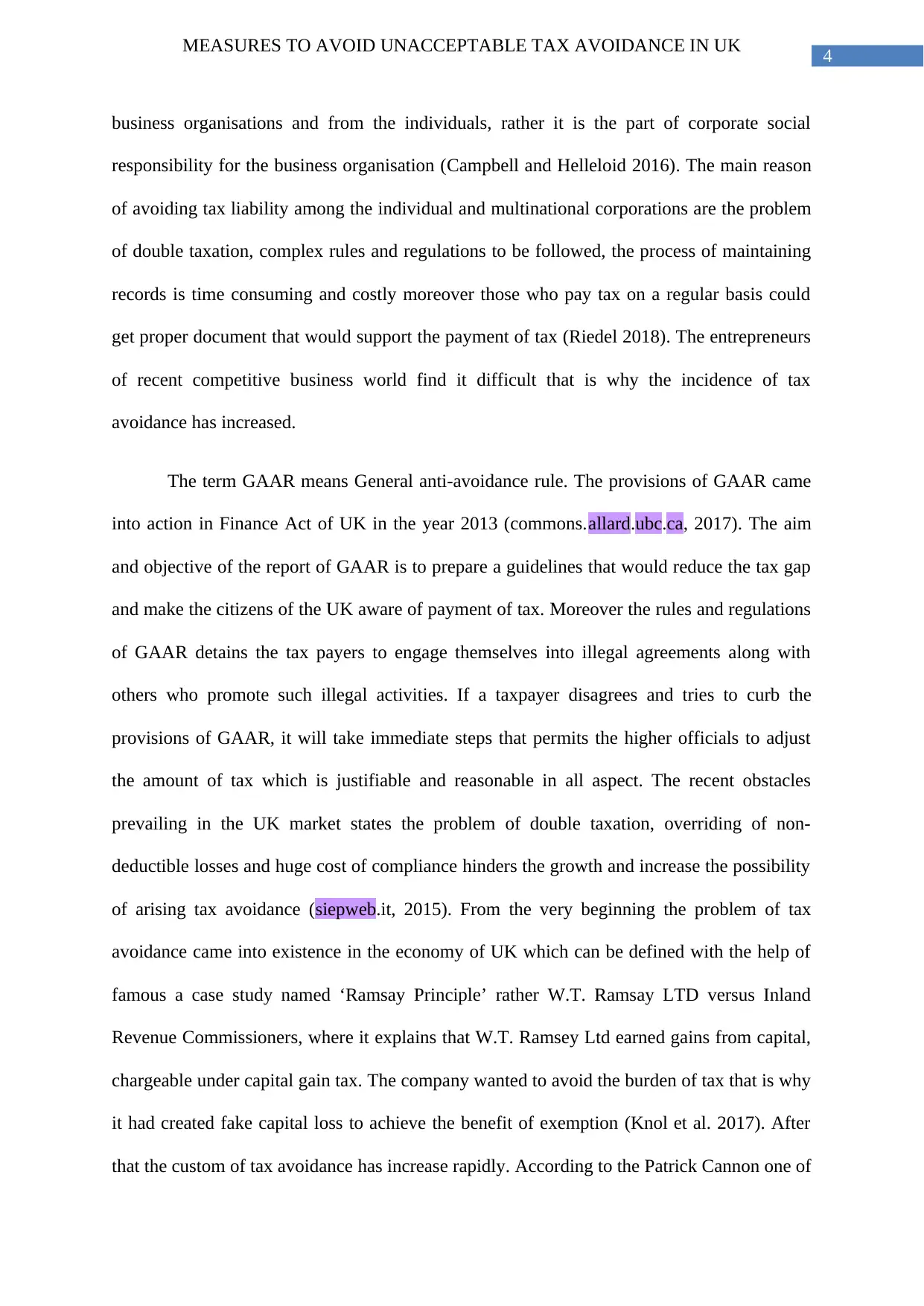
4
MEASURES TO AVOID UNACCEPTABLE TAX AVOIDANCE IN UK
business organisations and from the individuals, rather it is the part of corporate social
responsibility for the business organisation (Campbell and Helleloid 2016). The main reason
of avoiding tax liability among the individual and multinational corporations are the problem
of double taxation, complex rules and regulations to be followed, the process of maintaining
records is time consuming and costly moreover those who pay tax on a regular basis could
get proper document that would support the payment of tax (Riedel 2018). The entrepreneurs
of recent competitive business world find it difficult that is why the incidence of tax
avoidance has increased.
The term GAAR means General anti-avoidance rule. The provisions of GAAR came
into action in Finance Act of UK in the year 2013 (commons.allard.ubc.ca, 2017). The aim
and objective of the report of GAAR is to prepare a guidelines that would reduce the tax gap
and make the citizens of the UK aware of payment of tax. Moreover the rules and regulations
of GAAR detains the tax payers to engage themselves into illegal agreements along with
others who promote such illegal activities. If a taxpayer disagrees and tries to curb the
provisions of GAAR, it will take immediate steps that permits the higher officials to adjust
the amount of tax which is justifiable and reasonable in all aspect. The recent obstacles
prevailing in the UK market states the problem of double taxation, overriding of non-
deductible losses and huge cost of compliance hinders the growth and increase the possibility
of arising tax avoidance (siepweb.it, 2015). From the very beginning the problem of tax
avoidance came into existence in the economy of UK which can be defined with the help of
famous a case study named ‘Ramsay Principle’ rather W.T. Ramsay LTD versus Inland
Revenue Commissioners, where it explains that W.T. Ramsey Ltd earned gains from capital,
chargeable under capital gain tax. The company wanted to avoid the burden of tax that is why
it had created fake capital loss to achieve the benefit of exemption (Knol et al. 2017). After
that the custom of tax avoidance has increase rapidly. According to the Patrick Cannon one of
MEASURES TO AVOID UNACCEPTABLE TAX AVOIDANCE IN UK
business organisations and from the individuals, rather it is the part of corporate social
responsibility for the business organisation (Campbell and Helleloid 2016). The main reason
of avoiding tax liability among the individual and multinational corporations are the problem
of double taxation, complex rules and regulations to be followed, the process of maintaining
records is time consuming and costly moreover those who pay tax on a regular basis could
get proper document that would support the payment of tax (Riedel 2018). The entrepreneurs
of recent competitive business world find it difficult that is why the incidence of tax
avoidance has increased.
The term GAAR means General anti-avoidance rule. The provisions of GAAR came
into action in Finance Act of UK in the year 2013 (commons.allard.ubc.ca, 2017). The aim
and objective of the report of GAAR is to prepare a guidelines that would reduce the tax gap
and make the citizens of the UK aware of payment of tax. Moreover the rules and regulations
of GAAR detains the tax payers to engage themselves into illegal agreements along with
others who promote such illegal activities. If a taxpayer disagrees and tries to curb the
provisions of GAAR, it will take immediate steps that permits the higher officials to adjust
the amount of tax which is justifiable and reasonable in all aspect. The recent obstacles
prevailing in the UK market states the problem of double taxation, overriding of non-
deductible losses and huge cost of compliance hinders the growth and increase the possibility
of arising tax avoidance (siepweb.it, 2015). From the very beginning the problem of tax
avoidance came into existence in the economy of UK which can be defined with the help of
famous a case study named ‘Ramsay Principle’ rather W.T. Ramsay LTD versus Inland
Revenue Commissioners, where it explains that W.T. Ramsey Ltd earned gains from capital,
chargeable under capital gain tax. The company wanted to avoid the burden of tax that is why
it had created fake capital loss to achieve the benefit of exemption (Knol et al. 2017). After
that the custom of tax avoidance has increase rapidly. According to the Patrick Cannon one of
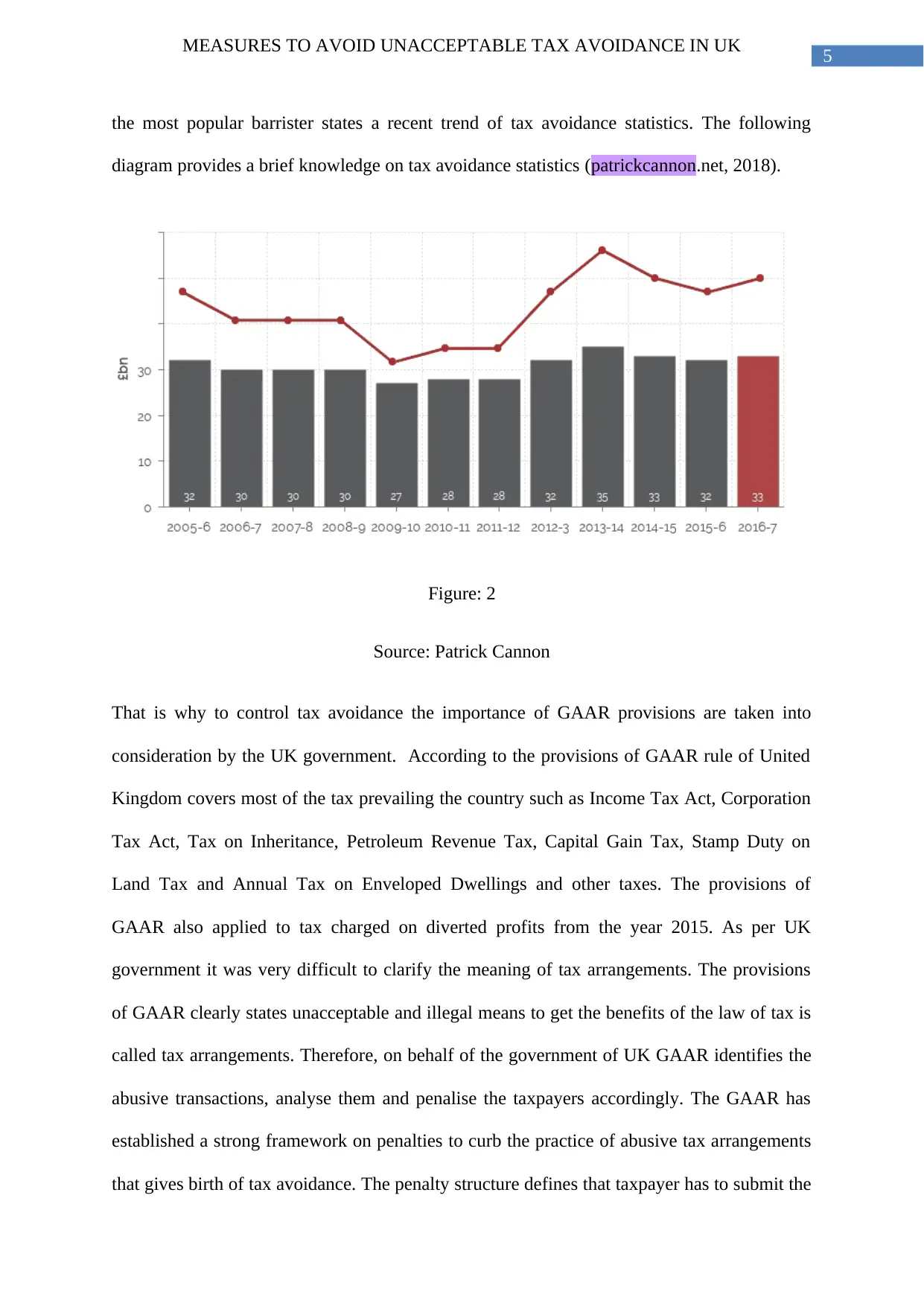
5
MEASURES TO AVOID UNACCEPTABLE TAX AVOIDANCE IN UK
the most popular barrister states a recent trend of tax avoidance statistics. The following
diagram provides a brief knowledge on tax avoidance statistics (patrickcannon.net, 2018).
Figure: 2
Source: Patrick Cannon
That is why to control tax avoidance the importance of GAAR provisions are taken into
consideration by the UK government. According to the provisions of GAAR rule of United
Kingdom covers most of the tax prevailing the country such as Income Tax Act, Corporation
Tax Act, Tax on Inheritance, Petroleum Revenue Tax, Capital Gain Tax, Stamp Duty on
Land Tax and Annual Tax on Enveloped Dwellings and other taxes. The provisions of
GAAR also applied to tax charged on diverted profits from the year 2015. As per UK
government it was very difficult to clarify the meaning of tax arrangements. The provisions
of GAAR clearly states unacceptable and illegal means to get the benefits of the law of tax is
called tax arrangements. Therefore, on behalf of the government of UK GAAR identifies the
abusive transactions, analyse them and penalise the taxpayers accordingly. The GAAR has
established a strong framework on penalties to curb the practice of abusive tax arrangements
that gives birth of tax avoidance. The penalty structure defines that taxpayer has to submit the
MEASURES TO AVOID UNACCEPTABLE TAX AVOIDANCE IN UK
the most popular barrister states a recent trend of tax avoidance statistics. The following
diagram provides a brief knowledge on tax avoidance statistics (patrickcannon.net, 2018).
Figure: 2
Source: Patrick Cannon
That is why to control tax avoidance the importance of GAAR provisions are taken into
consideration by the UK government. According to the provisions of GAAR rule of United
Kingdom covers most of the tax prevailing the country such as Income Tax Act, Corporation
Tax Act, Tax on Inheritance, Petroleum Revenue Tax, Capital Gain Tax, Stamp Duty on
Land Tax and Annual Tax on Enveloped Dwellings and other taxes. The provisions of
GAAR also applied to tax charged on diverted profits from the year 2015. As per UK
government it was very difficult to clarify the meaning of tax arrangements. The provisions
of GAAR clearly states unacceptable and illegal means to get the benefits of the law of tax is
called tax arrangements. Therefore, on behalf of the government of UK GAAR identifies the
abusive transactions, analyse them and penalise the taxpayers accordingly. The GAAR has
established a strong framework on penalties to curb the practice of abusive tax arrangements
that gives birth of tax avoidance. The penalty structure defines that taxpayer has to submit the
⊘ This is a preview!⊘
Do you want full access?
Subscribe today to unlock all pages.

Trusted by 1+ million students worldwide
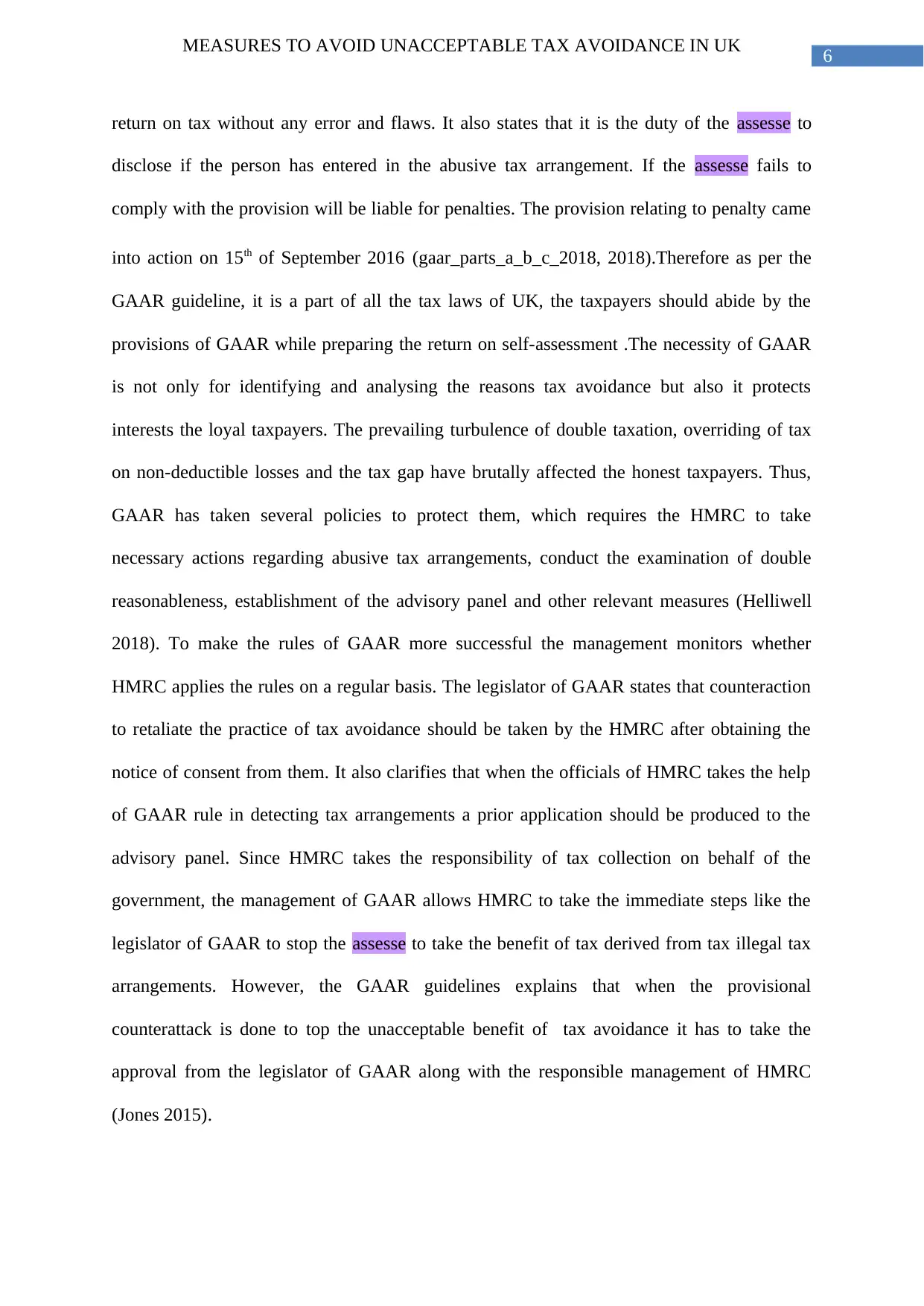
6
MEASURES TO AVOID UNACCEPTABLE TAX AVOIDANCE IN UK
return on tax without any error and flaws. It also states that it is the duty of the assesse to
disclose if the person has entered in the abusive tax arrangement. If the assesse fails to
comply with the provision will be liable for penalties. The provision relating to penalty came
into action on 15th of September 2016 (gaar_parts_a_b_c_2018, 2018).Therefore as per the
GAAR guideline, it is a part of all the tax laws of UK, the taxpayers should abide by the
provisions of GAAR while preparing the return on self-assessment .The necessity of GAAR
is not only for identifying and analysing the reasons tax avoidance but also it protects
interests the loyal taxpayers. The prevailing turbulence of double taxation, overriding of tax
on non-deductible losses and the tax gap have brutally affected the honest taxpayers. Thus,
GAAR has taken several policies to protect them, which requires the HMRC to take
necessary actions regarding abusive tax arrangements, conduct the examination of double
reasonableness, establishment of the advisory panel and other relevant measures (Helliwell
2018). To make the rules of GAAR more successful the management monitors whether
HMRC applies the rules on a regular basis. The legislator of GAAR states that counteraction
to retaliate the practice of tax avoidance should be taken by the HMRC after obtaining the
notice of consent from them. It also clarifies that when the officials of HMRC takes the help
of GAAR rule in detecting tax arrangements a prior application should be produced to the
advisory panel. Since HMRC takes the responsibility of tax collection on behalf of the
government, the management of GAAR allows HMRC to take the immediate steps like the
legislator of GAAR to stop the assesse to take the benefit of tax derived from tax illegal tax
arrangements. However, the GAAR guidelines explains that when the provisional
counterattack is done to top the unacceptable benefit of tax avoidance it has to take the
approval from the legislator of GAAR along with the responsible management of HMRC
(Jones 2015).
MEASURES TO AVOID UNACCEPTABLE TAX AVOIDANCE IN UK
return on tax without any error and flaws. It also states that it is the duty of the assesse to
disclose if the person has entered in the abusive tax arrangement. If the assesse fails to
comply with the provision will be liable for penalties. The provision relating to penalty came
into action on 15th of September 2016 (gaar_parts_a_b_c_2018, 2018).Therefore as per the
GAAR guideline, it is a part of all the tax laws of UK, the taxpayers should abide by the
provisions of GAAR while preparing the return on self-assessment .The necessity of GAAR
is not only for identifying and analysing the reasons tax avoidance but also it protects
interests the loyal taxpayers. The prevailing turbulence of double taxation, overriding of tax
on non-deductible losses and the tax gap have brutally affected the honest taxpayers. Thus,
GAAR has taken several policies to protect them, which requires the HMRC to take
necessary actions regarding abusive tax arrangements, conduct the examination of double
reasonableness, establishment of the advisory panel and other relevant measures (Helliwell
2018). To make the rules of GAAR more successful the management monitors whether
HMRC applies the rules on a regular basis. The legislator of GAAR states that counteraction
to retaliate the practice of tax avoidance should be taken by the HMRC after obtaining the
notice of consent from them. It also clarifies that when the officials of HMRC takes the help
of GAAR rule in detecting tax arrangements a prior application should be produced to the
advisory panel. Since HMRC takes the responsibility of tax collection on behalf of the
government, the management of GAAR allows HMRC to take the immediate steps like the
legislator of GAAR to stop the assesse to take the benefit of tax derived from tax illegal tax
arrangements. However, the GAAR guidelines explains that when the provisional
counterattack is done to top the unacceptable benefit of tax avoidance it has to take the
approval from the legislator of GAAR along with the responsible management of HMRC
(Jones 2015).
Paraphrase This Document
Need a fresh take? Get an instant paraphrase of this document with our AI Paraphraser
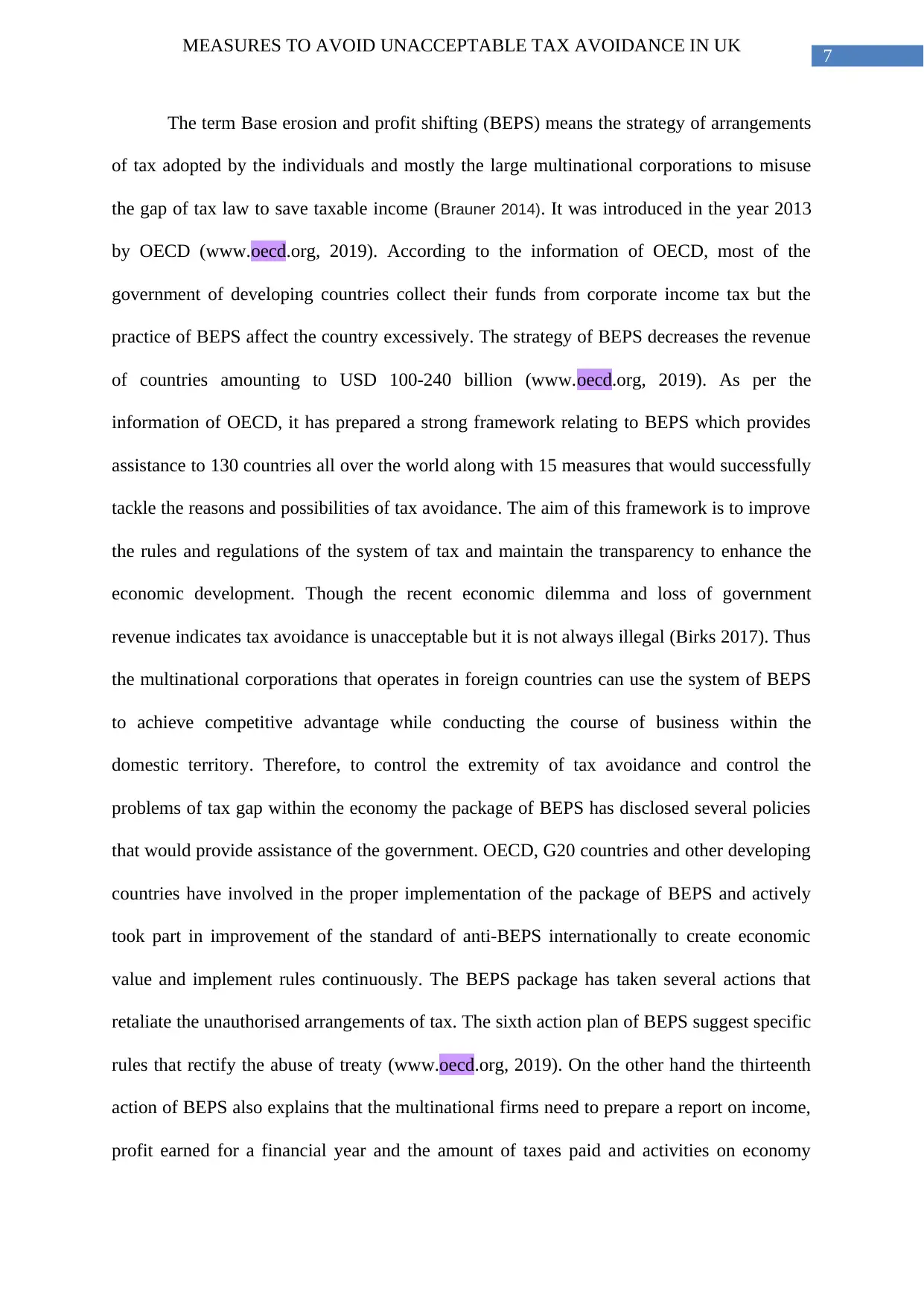
7
MEASURES TO AVOID UNACCEPTABLE TAX AVOIDANCE IN UK
The term Base erosion and profit shifting (BEPS) means the strategy of arrangements
of tax adopted by the individuals and mostly the large multinational corporations to misuse
the gap of tax law to save taxable income (Brauner 2014). It was introduced in the year 2013
by OECD (www.oecd.org, 2019). According to the information of OECD, most of the
government of developing countries collect their funds from corporate income tax but the
practice of BEPS affect the country excessively. The strategy of BEPS decreases the revenue
of countries amounting to USD 100-240 billion (www.oecd.org, 2019). As per the
information of OECD, it has prepared a strong framework relating to BEPS which provides
assistance to 130 countries all over the world along with 15 measures that would successfully
tackle the reasons and possibilities of tax avoidance. The aim of this framework is to improve
the rules and regulations of the system of tax and maintain the transparency to enhance the
economic development. Though the recent economic dilemma and loss of government
revenue indicates tax avoidance is unacceptable but it is not always illegal (Birks 2017). Thus
the multinational corporations that operates in foreign countries can use the system of BEPS
to achieve competitive advantage while conducting the course of business within the
domestic territory. Therefore, to control the extremity of tax avoidance and control the
problems of tax gap within the economy the package of BEPS has disclosed several policies
that would provide assistance of the government. OECD, G20 countries and other developing
countries have involved in the proper implementation of the package of BEPS and actively
took part in improvement of the standard of anti-BEPS internationally to create economic
value and implement rules continuously. The BEPS package has taken several actions that
retaliate the unauthorised arrangements of tax. The sixth action plan of BEPS suggest specific
rules that rectify the abuse of treaty (www.oecd.org, 2019). On the other hand the thirteenth
action of BEPS also explains that the multinational firms need to prepare a report on income,
profit earned for a financial year and the amount of taxes paid and activities on economy
MEASURES TO AVOID UNACCEPTABLE TAX AVOIDANCE IN UK
The term Base erosion and profit shifting (BEPS) means the strategy of arrangements
of tax adopted by the individuals and mostly the large multinational corporations to misuse
the gap of tax law to save taxable income (Brauner 2014). It was introduced in the year 2013
by OECD (www.oecd.org, 2019). According to the information of OECD, most of the
government of developing countries collect their funds from corporate income tax but the
practice of BEPS affect the country excessively. The strategy of BEPS decreases the revenue
of countries amounting to USD 100-240 billion (www.oecd.org, 2019). As per the
information of OECD, it has prepared a strong framework relating to BEPS which provides
assistance to 130 countries all over the world along with 15 measures that would successfully
tackle the reasons and possibilities of tax avoidance. The aim of this framework is to improve
the rules and regulations of the system of tax and maintain the transparency to enhance the
economic development. Though the recent economic dilemma and loss of government
revenue indicates tax avoidance is unacceptable but it is not always illegal (Birks 2017). Thus
the multinational corporations that operates in foreign countries can use the system of BEPS
to achieve competitive advantage while conducting the course of business within the
domestic territory. Therefore, to control the extremity of tax avoidance and control the
problems of tax gap within the economy the package of BEPS has disclosed several policies
that would provide assistance of the government. OECD, G20 countries and other developing
countries have involved in the proper implementation of the package of BEPS and actively
took part in improvement of the standard of anti-BEPS internationally to create economic
value and implement rules continuously. The BEPS package has taken several actions that
retaliate the unauthorised arrangements of tax. The sixth action plan of BEPS suggest specific
rules that rectify the abuse of treaty (www.oecd.org, 2019). On the other hand the thirteenth
action of BEPS also explains that the multinational firms need to prepare a report on income,
profit earned for a financial year and the amount of taxes paid and activities on economy
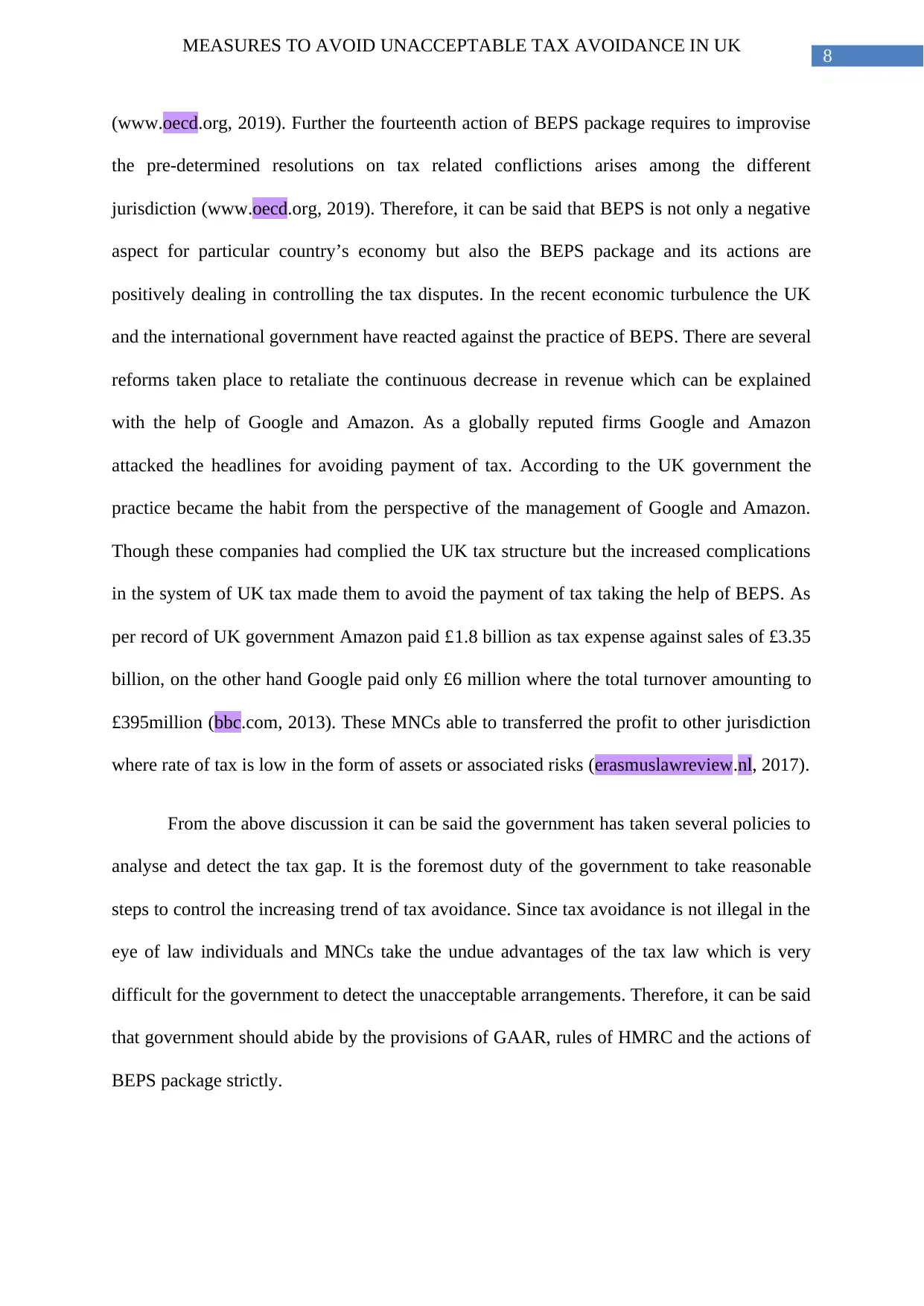
8
MEASURES TO AVOID UNACCEPTABLE TAX AVOIDANCE IN UK
(www.oecd.org, 2019). Further the fourteenth action of BEPS package requires to improvise
the pre-determined resolutions on tax related conflictions arises among the different
jurisdiction (www.oecd.org, 2019). Therefore, it can be said that BEPS is not only a negative
aspect for particular country’s economy but also the BEPS package and its actions are
positively dealing in controlling the tax disputes. In the recent economic turbulence the UK
and the international government have reacted against the practice of BEPS. There are several
reforms taken place to retaliate the continuous decrease in revenue which can be explained
with the help of Google and Amazon. As a globally reputed firms Google and Amazon
attacked the headlines for avoiding payment of tax. According to the UK government the
practice became the habit from the perspective of the management of Google and Amazon.
Though these companies had complied the UK tax structure but the increased complications
in the system of UK tax made them to avoid the payment of tax taking the help of BEPS. As
per record of UK government Amazon paid £1.8 billion as tax expense against sales of £3.35
billion, on the other hand Google paid only £6 million where the total turnover amounting to
£395million (bbc.com, 2013). These MNCs able to transferred the profit to other jurisdiction
where rate of tax is low in the form of assets or associated risks (erasmuslawreview.nl, 2017).
From the above discussion it can be said the government has taken several policies to
analyse and detect the tax gap. It is the foremost duty of the government to take reasonable
steps to control the increasing trend of tax avoidance. Since tax avoidance is not illegal in the
eye of law individuals and MNCs take the undue advantages of the tax law which is very
difficult for the government to detect the unacceptable arrangements. Therefore, it can be said
that government should abide by the provisions of GAAR, rules of HMRC and the actions of
BEPS package strictly.
MEASURES TO AVOID UNACCEPTABLE TAX AVOIDANCE IN UK
(www.oecd.org, 2019). Further the fourteenth action of BEPS package requires to improvise
the pre-determined resolutions on tax related conflictions arises among the different
jurisdiction (www.oecd.org, 2019). Therefore, it can be said that BEPS is not only a negative
aspect for particular country’s economy but also the BEPS package and its actions are
positively dealing in controlling the tax disputes. In the recent economic turbulence the UK
and the international government have reacted against the practice of BEPS. There are several
reforms taken place to retaliate the continuous decrease in revenue which can be explained
with the help of Google and Amazon. As a globally reputed firms Google and Amazon
attacked the headlines for avoiding payment of tax. According to the UK government the
practice became the habit from the perspective of the management of Google and Amazon.
Though these companies had complied the UK tax structure but the increased complications
in the system of UK tax made them to avoid the payment of tax taking the help of BEPS. As
per record of UK government Amazon paid £1.8 billion as tax expense against sales of £3.35
billion, on the other hand Google paid only £6 million where the total turnover amounting to
£395million (bbc.com, 2013). These MNCs able to transferred the profit to other jurisdiction
where rate of tax is low in the form of assets or associated risks (erasmuslawreview.nl, 2017).
From the above discussion it can be said the government has taken several policies to
analyse and detect the tax gap. It is the foremost duty of the government to take reasonable
steps to control the increasing trend of tax avoidance. Since tax avoidance is not illegal in the
eye of law individuals and MNCs take the undue advantages of the tax law which is very
difficult for the government to detect the unacceptable arrangements. Therefore, it can be said
that government should abide by the provisions of GAAR, rules of HMRC and the actions of
BEPS package strictly.
⊘ This is a preview!⊘
Do you want full access?
Subscribe today to unlock all pages.

Trusted by 1+ million students worldwide
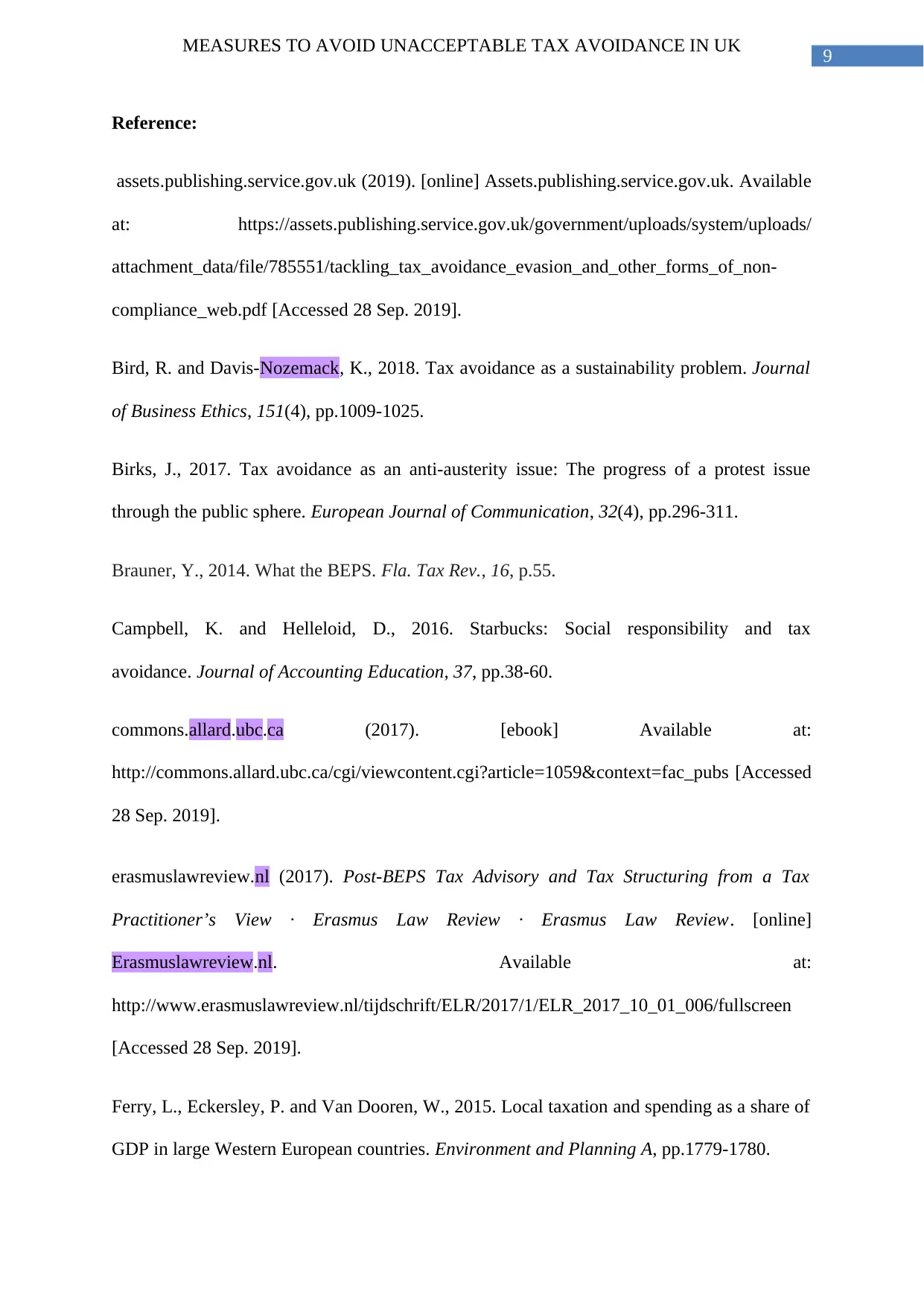
9
MEASURES TO AVOID UNACCEPTABLE TAX AVOIDANCE IN UK
Reference:
assets.publishing.service.gov.uk (2019). [online] Assets.publishing.service.gov.uk. Available
at: https://assets.publishing.service.gov.uk/government/uploads/system/uploads/
attachment_data/file/785551/tackling_tax_avoidance_evasion_and_other_forms_of_non-
compliance_web.pdf [Accessed 28 Sep. 2019].
Bird, R. and Davis-Nozemack, K., 2018. Tax avoidance as a sustainability problem. Journal
of Business Ethics, 151(4), pp.1009-1025.
Birks, J., 2017. Tax avoidance as an anti-austerity issue: The progress of a protest issue
through the public sphere. European Journal of Communication, 32(4), pp.296-311.
Brauner, Y., 2014. What the BEPS. Fla. Tax Rev., 16, p.55.
Campbell, K. and Helleloid, D., 2016. Starbucks: Social responsibility and tax
avoidance. Journal of Accounting Education, 37, pp.38-60.
commons.allard.ubc.ca (2017). [ebook] Available at:
http://commons.allard.ubc.ca/cgi/viewcontent.cgi?article=1059&context=fac_pubs [Accessed
28 Sep. 2019].
erasmuslawreview.nl (2017). Post-BEPS Tax Advisory and Tax Structuring from a Tax
Practitioner’s View · Erasmus Law Review · Erasmus Law Review. [online]
Erasmuslawreview.nl. Available at:
http://www.erasmuslawreview.nl/tijdschrift/ELR/2017/1/ELR_2017_10_01_006/fullscreen
[Accessed 28 Sep. 2019].
Ferry, L., Eckersley, P. and Van Dooren, W., 2015. Local taxation and spending as a share of
GDP in large Western European countries. Environment and Planning A, pp.1779-1780.
MEASURES TO AVOID UNACCEPTABLE TAX AVOIDANCE IN UK
Reference:
assets.publishing.service.gov.uk (2019). [online] Assets.publishing.service.gov.uk. Available
at: https://assets.publishing.service.gov.uk/government/uploads/system/uploads/
attachment_data/file/785551/tackling_tax_avoidance_evasion_and_other_forms_of_non-
compliance_web.pdf [Accessed 28 Sep. 2019].
Bird, R. and Davis-Nozemack, K., 2018. Tax avoidance as a sustainability problem. Journal
of Business Ethics, 151(4), pp.1009-1025.
Birks, J., 2017. Tax avoidance as an anti-austerity issue: The progress of a protest issue
through the public sphere. European Journal of Communication, 32(4), pp.296-311.
Brauner, Y., 2014. What the BEPS. Fla. Tax Rev., 16, p.55.
Campbell, K. and Helleloid, D., 2016. Starbucks: Social responsibility and tax
avoidance. Journal of Accounting Education, 37, pp.38-60.
commons.allard.ubc.ca (2017). [ebook] Available at:
http://commons.allard.ubc.ca/cgi/viewcontent.cgi?article=1059&context=fac_pubs [Accessed
28 Sep. 2019].
erasmuslawreview.nl (2017). Post-BEPS Tax Advisory and Tax Structuring from a Tax
Practitioner’s View · Erasmus Law Review · Erasmus Law Review. [online]
Erasmuslawreview.nl. Available at:
http://www.erasmuslawreview.nl/tijdschrift/ELR/2017/1/ELR_2017_10_01_006/fullscreen
[Accessed 28 Sep. 2019].
Ferry, L., Eckersley, P. and Van Dooren, W., 2015. Local taxation and spending as a share of
GDP in large Western European countries. Environment and Planning A, pp.1779-1780.
Paraphrase This Document
Need a fresh take? Get an instant paraphrase of this document with our AI Paraphraser
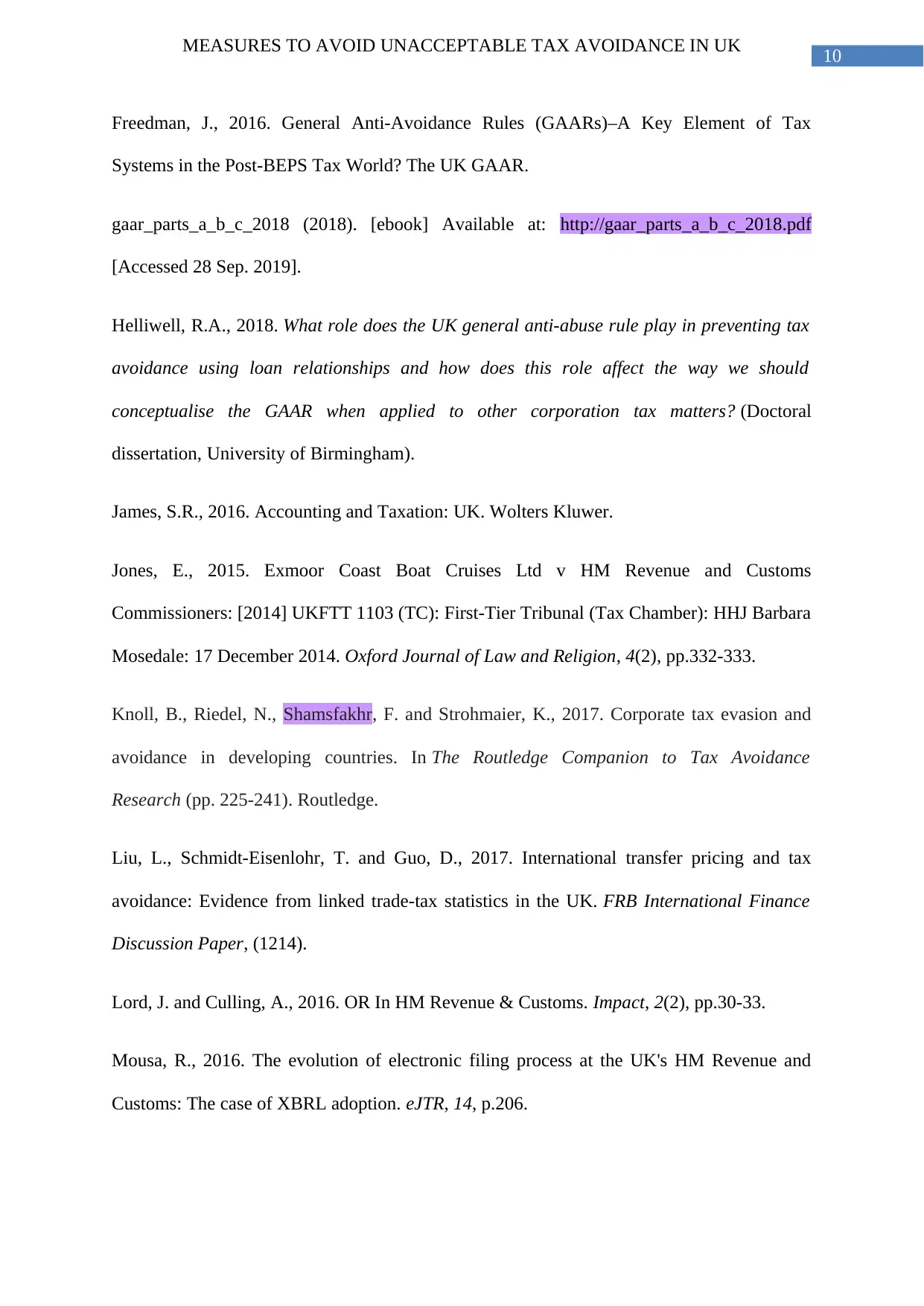
10
MEASURES TO AVOID UNACCEPTABLE TAX AVOIDANCE IN UK
Freedman, J., 2016. General Anti-Avoidance Rules (GAARs)–A Key Element of Tax
Systems in the Post-BEPS Tax World? The UK GAAR.
gaar_parts_a_b_c_2018 (2018). [ebook] Available at: http://gaar_parts_a_b_c_2018.pdf
[Accessed 28 Sep. 2019].
Helliwell, R.A., 2018. What role does the UK general anti-abuse rule play in preventing tax
avoidance using loan relationships and how does this role affect the way we should
conceptualise the GAAR when applied to other corporation tax matters? (Doctoral
dissertation, University of Birmingham).
James, S.R., 2016. Accounting and Taxation: UK. Wolters Kluwer.
Jones, E., 2015. Exmoor Coast Boat Cruises Ltd v HM Revenue and Customs
Commissioners: [2014] UKFTT 1103 (TC): First-Tier Tribunal (Tax Chamber): HHJ Barbara
Mosedale: 17 December 2014. Oxford Journal of Law and Religion, 4(2), pp.332-333.
Knoll, B., Riedel, N., Shamsfakhr, F. and Strohmaier, K., 2017. Corporate tax evasion and
avoidance in developing countries. In The Routledge Companion to Tax Avoidance
Research (pp. 225-241). Routledge.
Liu, L., Schmidt-Eisenlohr, T. and Guo, D., 2017. International transfer pricing and tax
avoidance: Evidence from linked trade-tax statistics in the UK. FRB International Finance
Discussion Paper, (1214).
Lord, J. and Culling, A., 2016. OR In HM Revenue & Customs. Impact, 2(2), pp.30-33.
Mousa, R., 2016. The evolution of electronic filing process at the UK's HM Revenue and
Customs: The case of XBRL adoption. eJTR, 14, p.206.
MEASURES TO AVOID UNACCEPTABLE TAX AVOIDANCE IN UK
Freedman, J., 2016. General Anti-Avoidance Rules (GAARs)–A Key Element of Tax
Systems in the Post-BEPS Tax World? The UK GAAR.
gaar_parts_a_b_c_2018 (2018). [ebook] Available at: http://gaar_parts_a_b_c_2018.pdf
[Accessed 28 Sep. 2019].
Helliwell, R.A., 2018. What role does the UK general anti-abuse rule play in preventing tax
avoidance using loan relationships and how does this role affect the way we should
conceptualise the GAAR when applied to other corporation tax matters? (Doctoral
dissertation, University of Birmingham).
James, S.R., 2016. Accounting and Taxation: UK. Wolters Kluwer.
Jones, E., 2015. Exmoor Coast Boat Cruises Ltd v HM Revenue and Customs
Commissioners: [2014] UKFTT 1103 (TC): First-Tier Tribunal (Tax Chamber): HHJ Barbara
Mosedale: 17 December 2014. Oxford Journal of Law and Religion, 4(2), pp.332-333.
Knoll, B., Riedel, N., Shamsfakhr, F. and Strohmaier, K., 2017. Corporate tax evasion and
avoidance in developing countries. In The Routledge Companion to Tax Avoidance
Research (pp. 225-241). Routledge.
Liu, L., Schmidt-Eisenlohr, T. and Guo, D., 2017. International transfer pricing and tax
avoidance: Evidence from linked trade-tax statistics in the UK. FRB International Finance
Discussion Paper, (1214).
Lord, J. and Culling, A., 2016. OR In HM Revenue & Customs. Impact, 2(2), pp.30-33.
Mousa, R., 2016. The evolution of electronic filing process at the UK's HM Revenue and
Customs: The case of XBRL adoption. eJTR, 14, p.206.
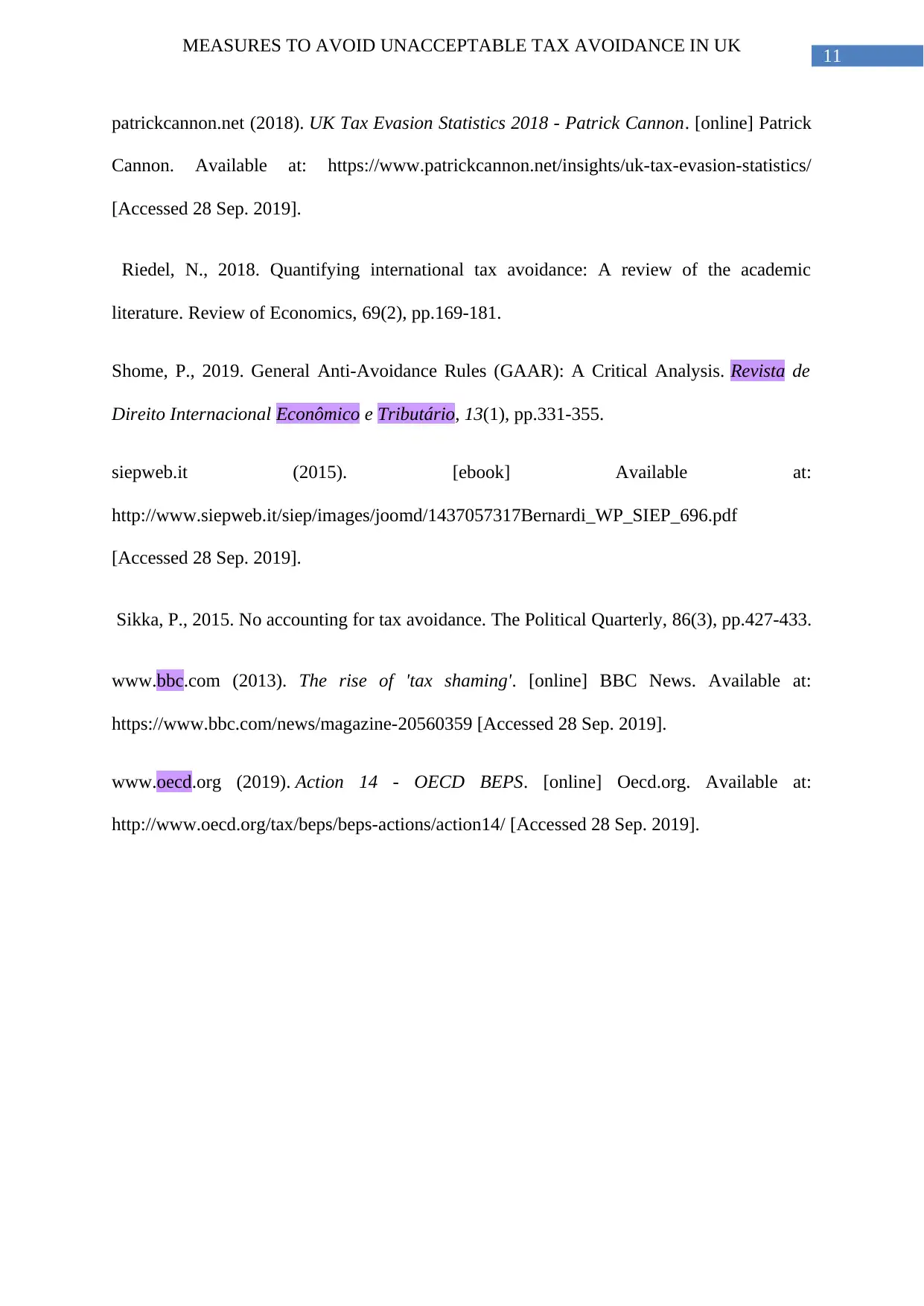
11
MEASURES TO AVOID UNACCEPTABLE TAX AVOIDANCE IN UK
patrickcannon.net (2018). UK Tax Evasion Statistics 2018 - Patrick Cannon. [online] Patrick
Cannon. Available at: https://www.patrickcannon.net/insights/uk-tax-evasion-statistics/
[Accessed 28 Sep. 2019].
Riedel, N., 2018. Quantifying international tax avoidance: A review of the academic
literature. Review of Economics, 69(2), pp.169-181.
Shome, P., 2019. General Anti-Avoidance Rules (GAAR): A Critical Analysis. Revista de
Direito Internacional Econômico e Tributário, 13(1), pp.331-355.
siepweb.it (2015). [ebook] Available at:
http://www.siepweb.it/siep/images/joomd/1437057317Bernardi_WP_SIEP_696.pdf
[Accessed 28 Sep. 2019].
Sikka, P., 2015. No accounting for tax avoidance. The Political Quarterly, 86(3), pp.427-433.
www.bbc.com (2013). The rise of 'tax shaming'. [online] BBC News. Available at:
https://www.bbc.com/news/magazine-20560359 [Accessed 28 Sep. 2019].
www.oecd.org (2019). Action 14 - OECD BEPS. [online] Oecd.org. Available at:
http://www.oecd.org/tax/beps/beps-actions/action14/ [Accessed 28 Sep. 2019].
MEASURES TO AVOID UNACCEPTABLE TAX AVOIDANCE IN UK
patrickcannon.net (2018). UK Tax Evasion Statistics 2018 - Patrick Cannon. [online] Patrick
Cannon. Available at: https://www.patrickcannon.net/insights/uk-tax-evasion-statistics/
[Accessed 28 Sep. 2019].
Riedel, N., 2018. Quantifying international tax avoidance: A review of the academic
literature. Review of Economics, 69(2), pp.169-181.
Shome, P., 2019. General Anti-Avoidance Rules (GAAR): A Critical Analysis. Revista de
Direito Internacional Econômico e Tributário, 13(1), pp.331-355.
siepweb.it (2015). [ebook] Available at:
http://www.siepweb.it/siep/images/joomd/1437057317Bernardi_WP_SIEP_696.pdf
[Accessed 28 Sep. 2019].
Sikka, P., 2015. No accounting for tax avoidance. The Political Quarterly, 86(3), pp.427-433.
www.bbc.com (2013). The rise of 'tax shaming'. [online] BBC News. Available at:
https://www.bbc.com/news/magazine-20560359 [Accessed 28 Sep. 2019].
www.oecd.org (2019). Action 14 - OECD BEPS. [online] Oecd.org. Available at:
http://www.oecd.org/tax/beps/beps-actions/action14/ [Accessed 28 Sep. 2019].
⊘ This is a preview!⊘
Do you want full access?
Subscribe today to unlock all pages.

Trusted by 1+ million students worldwide
1 out of 12
Related Documents
Your All-in-One AI-Powered Toolkit for Academic Success.
+13062052269
info@desklib.com
Available 24*7 on WhatsApp / Email
![[object Object]](/_next/static/media/star-bottom.7253800d.svg)
Unlock your academic potential
Copyright © 2020–2025 A2Z Services. All Rights Reserved. Developed and managed by ZUCOL.





